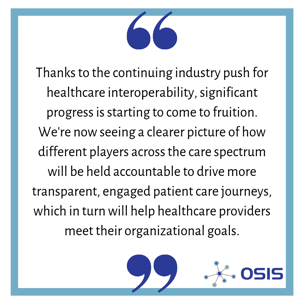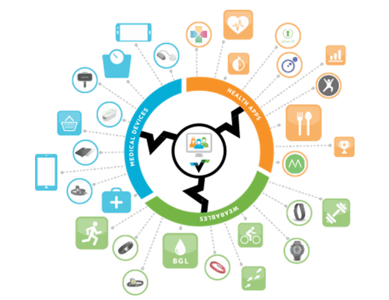Healthcare providers are adapting at different paces when it comes to improving healthcare interoperability. This is a top priority for clinicians, health systems, and patients for ease of access into digital health information. Healthcare interoperability is a topic that some see as a barrier, but others have embraced technology and are progressing. To highlight the progress and the barriers of healthcare interoperability, we need to first look at what defines it.
Interoperability relative to healthcare is defined as the ability of computer systems or software to share and make use of patient information. The Office of the National Coordinator (ONC) Cures Act Final Rule, went into effect on June 30, 2020 and is intended to implement interoperability requirements to empower patients and ensure they have access information about the cost and outcomes of their care. The ONC rule defines demands for healthcare and IT providers around data sharing and outlines exceptions to the restrictions on Information Blocking.
The information exchange among health systems is flowing faster than ever before, and modern technology innovations are bringing more usable digital health information to providers and beyond. From stacks of paper charts to an inbox, or a Provider Approval Queue (PAQ), workloads have changed. Unfortunately, some of the same habits developed at the time of early paper charting are still present today but have progressed through the adoption of health interoperability.
2021 Barriers to Healthcare Interoperability
For all the progress made, there are still challenges. Below we uncover many of the barriers of interoperability in healthcare.
Patient Identification Inconsistencies - Patient identification is by name, date of birth, or Social Security number and is often stored differently and is often inconsistent. The health care system does not have a universal way to identify patients, so the lack of conformity is an obstacle.
Timeliness - Not everything moves at real time or even near real time, so there may be delays. There may also be some downtime associated with the movement of data.
Management - Incoming and outgoing data like referrals or test results may depend on responses from external resource documentation.
Accessibility - Direct access to a one-stop, single sign-on system to improve clinical decision-making to improve care and provide better health outcomes for patients, is still a work in progress.
Data Blocking - Deliberately or not, data blocking is against federal regulations. Health systems may require an update to processes and workflow to avoid data blocking from one source to the other.
Data overload - Having so much data at our fingertips presents an everyday risk. It is critical to have a process that determines priority information and a process for screening and managing data.
Lack of National Health Information Exchange (HIE) - A national HIE exchange is a work in progress and may require another system/platform to support data conversions to match formatting and fields to allow these systems to share data accurately. We are moving closer to the development of this national platform. Applications used in healthcare do not follow one standard for data formats, and data sharing is difficult because of this.
The first preference we recommend enabling is the Display PDR Brief. This preference allows the Physician Desk Reference brief panel to display a brief article and additional information on the medications. Having these resources readily available reduces time spent looking up specifics on medications and enhances the provider’s workflow.
Interoperability Moving Forward
After looking at the challenges healthcare systems face with interoperability, progress has been made over the last decade in the following areas:
Patient Data Aggregation - Allowing an organization to bring many different pieces of data to a single location is the basis for the transformation from volume-to value-based care. With organizations able to find data streamlined into one place, this helps to process substantial amounts of data in return create insights, trends, and predictions for the organization. This gives us a view of the “whole person”.
Patient Data Flow - Nationally, channels are opening in standardization. There is a National Strategy managed by The Sequoia Project, a non-profit 501(c)(3) to advance the implementation of secure, interoperable nationwide health information exchange. Chartered in 2012 by the ONC, The Sequoia Project has now grown to become the largest health information exchange network in the country.
Easier access - With more hospitals, clinicians, and health systems tackling interoperability there are now several doors open to direct access information.
Automation - The ability to set workflows and rules to assist in automation and avoiding manually entering the patient data coming in. Automation allows for better workflows, reduces ambiguity, and enables data transmission among Electronic Health Record (EHR) systems and health care stakeholders to help reduce staff burden.
ONC CEHRT (Certified Electronic Health Record Technology) Criteria - Raising the bar in 2021, Promoting Interoperability Program now addresses and enforces the Common-Clinical Data Set (CCDS) and the Consolidated-Clinical Document Architecture (C-CDA) standards to improve and support the use of APIs and revise View Download and Transmit (VDT) criteria.
To learn more about interoperability, the HITEQ Center offers rationale for Community Health Centers (CHCs) to participate in HIE and provides Training and Technical Assistance (T/TA) references for assistance and guidance to help address healthcare interoperability. Through these resources, providers can learn more of the mission y and how it creates a positive impact with population health. Through interoperability, Patient Center Medical Home (PCMH) promotes coordination in care services for patients and helps reduce duplicated services between healthcare systems. The HITEQ Center also offers resources on payment reform initiatives to reduce ER/Hospital admissions that affect total cost of care.

To pave the way for true improvement in healthcare interoperability, organizations need to focus their time and resources on normalized and complete patient information, as well as high-quality structured and standardized data. At OSIS, we continue to push for progress in healthcare interoperability and for a more engaged patient care journey. We recommend health centers to participate in the Health Interoperability Outcomes 2030 feedback submission form. to help with future standardization for interoperability. The ONC will gather the outcomes as we journey down the roadmap towards healthcare interoperability.
Resources
Official Website of The Office of the National Coordinator for Health Information Technology (ONC), https://www.healthit.gov/
Health Information Technology, Evaluation, and Quality Center Website (HITEQ Center), https://hiteqcenter.apps.plantanapp.com/
